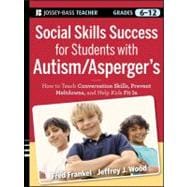
Note: Supplemental materials are not guaranteed with Rental or Used book purchases.
Purchase Benefits
Looking to rent a book? Rent Social Skills Success for Students with Autism / Asperger's Helping Adolescents on the Spectrum to Fit In [ISBN: 9780470952382] for the semester, quarter, and short term or search our site for other textbooks by Frankel, Fred; Wood, Jeffrey J.. Renting a textbook can save you up to 90% from the cost of buying.
Jeffrey J. Wood, Ph.D., is an associate professor of Education and Psychiatry and Biobehavioral Sciences at UCLA, and is a licensed clinical psychologist. He is the coauthor of Child Anxiety Disorders and is researching cognitive-behavioral interventions for students with autism and Asperger's syndrome, childhood anxiety, and the development of children's close friendships.
Introduction
Our Approach to Social Skills Training
The Knowledge Base Behind This Book
Children's Friendship Training/PEERS
Cognitive-Behavioral Strategies for Emotional Self-Regulation
The Purpose of This Book
How to Use This Book
Part One: Basic Information About Teens with Autism Spectrum Disorder
Chapter 1: What Is Autism Spectrum Disorder?
Challenges Facing Neurotypical Teens
Becoming Independent from Parents
Preparing for a Vocation or Career
Adjusting to the Physical and Psychosexual Changes of Puberty
Developing Values and Identity
Establishing Effective Relationships with Peers
Symptoms of Autism Spectrum Disorders
Misleading Aspects of Communication
Deficits in Expression and Communication
Easily Corrected Deficits in Understanding Others
Coping with Anxiety-Producing Situations
Chapter 2: Making Inclusion More Successful for Students with Autism
History of the Inclusion Movement
Parent Views About Inclusion
Types of Educational Placement
Traditional Teacher Roles in Partially and Fully Included Classrooms
Research Findings on Inclusion
Social Integration into School Life
Mainstream Success of Students on the Autism Spectrum
Approaches for Social Inclusion with Neurotypical Teens
Teen Altruism
Chapter 3: Classroom Management and Social Skills Groups
Classroom Management for Teens with Autism Spectrum Disorders
Segregated Students
Partially Included Students
Fully Included Students
Consequences for Misbehavior
Organizing Social Skills Groups for Teens
How to Organize Groups at School
How to Have Teens Take the Class
How to Engage Teens in Class Discussions
Have Some Fun Activities
Have “Real-Life” Homework
Involving Parents in Social Skills Training
Part Two: Interventions for Basic Social Skills
Chapter 4: Helping Students Expand Their Interests
Problems in Conversation Versus Problems in Interests
Socially Functional Interests
Interference Due to Anxiety
Building on Current Interests
Assessing Teen Interests
Lessons to Expand Interests
Chapter 5: Improving Comprehension of Figurative Language
Idioms
Irony and Sarcasm
Types of Sarcasm
Recognizing Sarcasm
Teaching Sarcasm and Irony
Chapter 6: Improving Conversational Comprehension
Goals of Conversations
Ensuring Mutual Understanding
Conversational Repair Strategies
Teaching Better Task-Oriented Conversations, Accuracy Checks, and Repair Statements
Chapter 7: Improving Social Conversations
Potential Understanding of Conversational Goals
Small Talk
Parts of Conversations
Chapter 8: Helping Students Choose Friends
Neurotypical Teen Relationships
Friends of Teens with Autism Spectrum Disorders
The Internet and Friendships
Appropriate Friends for Teens on the Spectrum
Common Errors Adults Make in Offering Friendship Help
Requiring Inclusion
Attempting to Pair Students
Assigning Peer Buddies
How Educators Can Help Foster Friendships of Teens on the Spectrum
Part Three: More Intensive Interventions to Help Kids Fit In
Chapter 9: Understanding and Assessing Anxiety
How Anxiety Works
Clinical Levels of Anxiety
How Anxiety Exacerbates Symptoms of Autism Spectrum Disorder
Outbursts and Meltdowns
Types of Anxiety in Students with Autism
Social Anxiety
Generalized Anxiety
Separation Anxiety
Assessing Anxiety
Chapter 10: Interventions to Reduce Anxiety and Outbursts
Phase I: Skill Building
Knowing I’m Nervous
Irritating Thoughts
Calm Thoughts
Keep Practicing
Phase II: Practicing the Skills
Lesson Plans
Chapter 11: Preventing and Dealing with Victimization
Types of Victimization
Teasing
Physical Aggression
Bullying
Cyberbullying
Effective Ways of Handling Bullying
Teaching Safety
Improving Reputation Among Peers
Informal Approaches to Head Off Continuing Bullying
Effective Ways of Handling Cyberbullying
Chapter 12: Working with Peer Mentors
Commonly Used Alternatives to Mentoring
Job Description of the Cross-Age Mentor
Step 1: Selecting Mentors
Step 2: Selecting Mentees
Step 3: Mentor Orientation
Step 4: Matching Mentor and Mentee
Step 5: The Mentorship Term
Step 6: Assessment
Conclusion: Helping Kids with Autism Find Their Own Place in the World
References
Index
The New copy of this book will include any supplemental materials advertised. Please check the title of the book to determine if it should include any access cards, study guides, lab manuals, CDs, etc.
The Used, Rental and eBook copies of this book are not guaranteed to include any supplemental materials. Typically, only the book itself is included. This is true even if the title states it includes any access cards, study guides, lab manuals, CDs, etc.